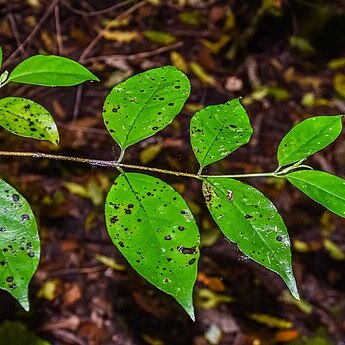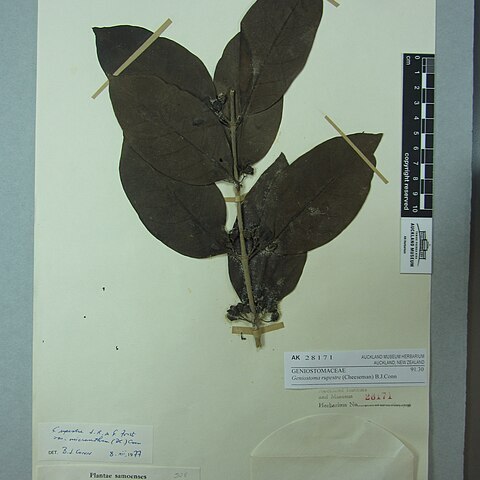Shrub or treelet, up to 6(-10) m high. Branches mostly terete, rarely quadrangular, glabrous or the young twigs shortly brown-to fulvous-tomentose. Leaves ovate to lanceolate, 1.5-17 by 0.5-6.5 cm, herbaceous to chartaceous, rarely coriaceous, glabrous or (mainly on the midrib beneath) shortly tomentose; base rounded to acute, rarely emarginate; margin entire or rarely faintly crenulate; apex blunt or acute to long-acuminate, aristulate or not; nerves (3-)6—10(-11) pairs; petiole 0.25-1(-1¾) cm. Inflorescences mostly axillary, sometimes partly ramiflorous, often glomerulous, not rarely laxly paniculate, sometimes umbelliform, with (1-)several flowers, 0.5-1.5(-4.5) cm, sparsely (to densely) shortly appressed-hairy, sometimes glabrous. Pedicels 1-5 mm. Calyx (⅔-)1-2(-2.25) mm high, sepals elliptic or ovate to broad-triangular, blunt to acute, outside glabrous to densely short-tomentose. Corolla (1½-)2½-4½ mm long, outside glabrous or rarely fairly densely papillose-hairy, inside the throat densely to sparsely hairy, sometimes a second ring of hairs near the base of the tube; lobes (¾-)1-2½ mm long, usually blunt, rarely acute. Stamens variable, especially as to hairiness; filaments (0.2-)0.5-0.75(-1) mm, glabrous to rather densely hairy; anthers 0.75-1.25 mm long, glabrous or hairy, appendage of the connective absent to as long as the cells, in the latter case (mainly in female flowers) triangular above the adnate cells. Ovary glabrous to densely shortly tomentose; style usually very short (less than 1/5 mm), in some forms (mainly in Sumatra, W. Java, and the Philippines) about 1(-2) mm, glabrous or rarely slightly pubescent. Fruits mostly slightly flattened-globose, rarely ellipsoid, ovoid, or obovoid, 4-7.5(-12) by 4-6 (-9) mm, black when ripe (sec. MERRILL whitish in G. philippinense, red in G. stenophyllum), septifragal (but see note).
More
Shrubs or small trees, to 6 m tall. Branchlets glabrous or when young shortly brown to tawny tomentose. Petiole 1 cm; leaf blade narrowly ovate to narrowly elliptic, 7--16 X 3.5--6 cm, papery to subleathery, abaxially glabrous or sparsely hairy along midvein, base rounded to narrowly cuneate, apex obtuse, acute, or acuminate, lateral veins 6--10 pairs. Cymes sometimes partly on old branches, 3--18-flowered, often congested, rarely laxly paniculate or umbelliform, ca. 1 cm, glabrous or with sparse short appressed hairs; peduncle ca. 5 mm; bracts ovate to triangular, 0.5--1 mm. Pedicel 3--5 mm. Sepals ovate to triangular, ca. 2 mm, outside glabrous to densely short tomentose. Corolla campanulate, 2--5 mm, outside glabrous or rarely papillose-hairy, inside pubescent at mouth and sometimes with a second ring of hairs near base of tube; lobes ovate, 1.5--1.8 X 1.5--1.8 mm. Anthers narrowly ovate. Ovary ovoid, 0.4--1 mm, glabrous to densely short tomentose. Style and stigma glabrous or slightly pubescent. Capsules globose, 5--10 mm in diam. Fl. May-Jun, fr. Aug-Oct.
A smooth shrub up to 3-8 m tall. The branches are very brittle and break easily. The leaves are opposite and oblong with a sharpened base. They are 10-12 cm long and 5-6 cm wide. The leaves are dark green and shiny. The leaf stalk is less than 1 cm long. The flowers are very small, white and in small branching clusters. There are 2-6 flowers per cluster. The fruit is oval and pointed. It is 5-8 mm long. Fruit are blackish. The plant varies a lot and has been split into several species by some authors.
Very variable, in the substage of the rainforest, but apparently preferring more open places, often in exposed sites, along forest edges and river-banks, in young secondary forests and shrubberies, on steep slopes and in grass fields, under everwet conditions, in regions subject to a dry season only, in the montane rain-forest, for example in the Lesser Sunda Is. only between 700-2200 m; from sea-level up to 2800 m.
More
A tropical plant. They grow near the seaside. They occur in several Pacific Islands. Plants require a protected position in well drained soil. They grow up to about 300 m. in Taiwan. In Samoa it grows from sea level to 1600 m altitude.



